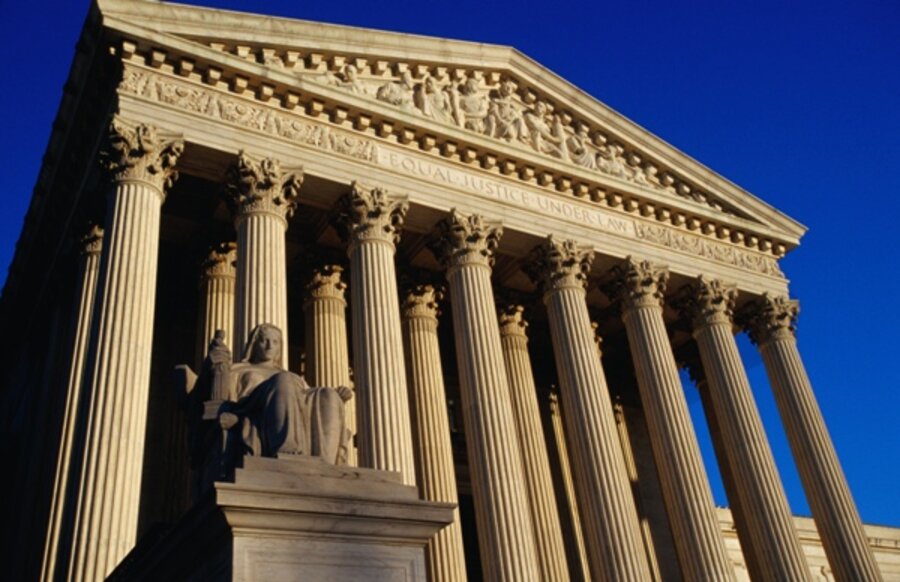Supreme Court hands police another victory in Miranda cases
Loading...
| Washington
The US Supreme Court on Wednesday made it easier for police to make repeated attempts to convince a criminal suspect to undergo questioning – even after that suspect has invoked the right to first consult a lawyer.
In a 7-to-2 decision, the justices said police could contact the suspect again, provided at least two weeks had passed since the initial attempt to interrogate the individual. In addition, the suspect must have also been released from police custody at least 14 days earlier.
The new rule emerged in the case of a Maryland man whose child abuse conviction was overturned by the Maryland Court of Appeals.
The man, Michael Shatzer, made incriminating statements to police about alleged child abuse during a 2006 interrogation. Mr. Shatzer was in prison at the time, serving a sentence for a different crime. Police had approached Shatzer two and a half years earlier, but he refused at that time to talk without first seeing a lawyer.
Were Miranda rights violated?
The issue in the case was whether Shatzer’s invocation of his Miranda rights in 2003 was violated by his subsequent interrogation by police in 2006. The Maryland Court of Appeals said it was. The state judges threw out incriminating statements Shatzer made to police and invalidated his conviction.
On Wednesday, all nine Supreme Court justices reversed that ruling. The court reasoned that two and a half years was enough time to allow police another opportunity to question Shatzer.
The decision is the second opinion involving Miranda warnings announced by the high court in as many days. On Tuesday the court upheld a version of the Miranda warnings used by Tampa police. The Florida Supreme Court had said the warnings were confusing, but the US Supreme Court said they were constitutionally adequate. (See Monitor analysis here.)
Both rulings are consistent with a trend at the high court of ruling for law enforcement in Miranda cases. Supreme Court rulings in this area have generally made it easier for police interrogators and more difficult for criminal suspects. (Monitor coverage of a key police interrogation case here.)
The key issue for the justices in Wednesday’s case was how to apply a 1981 legal precedent, Edwards v. Arizona. The Edwards decision created a presumption that once a suspect invokes the right to have counsel present during a police interrogation, any subsequent waiver of that right is to be considered involuntary. Involuntary statements are inadmissible as evidence in court.
Constitutional right against coerced self-incrimination
The 1981 Edwards decision was written in part to strengthen a suspect’s assertion of the right to a lawyer. Ultimately it is aimed at upholding Fifth Amendment protection against coerced self-incrimination while in police custody.
In the Shatzer case, all nine justices agreed that two and half years was a long enough break between the first attempted interrogation and the second. But only seven justices agreed to establish the arbitrary 14-day time limit for future cases.
“We think it appropriate to specify a period of time to avoid the consequence that continuation of the [open-ended] Edwards presumption will not reach the correct result most of the time,” Justice Antonin Scalia wrote for the majority. “It seems to us that period is 14 days.”
Justice Scalia added, “That provides plenty of time for the suspect to get reacclimated to his normal life, to consult with friends and counsel, and to shake off any residual coercive effects of his prior custody.”
Although he concurred in the judgment, Justice John Paul Stevens objected to creation of the 14-day rule. “The most troubling aspect of the court’s time-based rule is that it disregards the compulsion caused by a second (or third, or fourth) interrogation of an indigent suspect who was told that if he requests a lawyer, one will be provided for him.”
Stevens added: “If [the police] cease questioning and then reinterrogate the suspect 14 days later without providing him with a lawyer, the suspect is likely to feel that the police lied to him and that he really does not have any right to a lawyer.”
Stevens said a long break in time between attempted interrogations may diminish the compulsion felt by a suspect facing re-interrogation by police. But he added that 14 days was far too soon.





